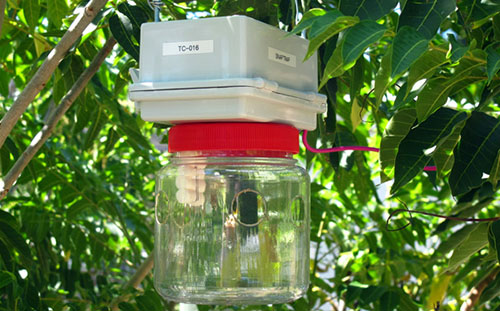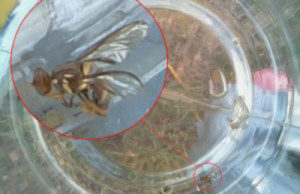
Recently there has been a lot of talk about ‘smart’ traps in fruit fly management, but what are they and what can they do?
In short, smart traps are based on the familiar sticky traps or pheromone traps, but use a combination of cameras or other sensors to provide up-to-date information about what is happening in an orchard and what insect pests are present. Like an automated weather station, a smart trap could greatly reduce the need to visit trap sites in person.
Smart traps have been used for other pests in a number of countries, but more recently there has been an increased interest in the role these could play in fruit fly management across Australia. Amongst the developments underway are RapidAim (CSIRO), TrapView (Adama), and the focus of this article, SnapTrap.
SnapTrap is a trapping system that has been developed and trialled ‘on-farm’ by Kim Khor. SnapTrap, which is an Australian innovation, is a digital camera system mounted onto the standard fruit fly traps used by state governments for pest monitoring, the Lynfield trap. The trap records a high-resolution photo every few hours during daylight and uploads these to the ‘cloud’ where they can be reviewed. Access to the images is via a secure website and can be done on any internet connected device such as a laptop or mobile phone.

Inset of fruit fly captured in SnapTrap. Image taken with TrapCam
Alongside trap contents, SnapTrap also records temperature logs and information from other environmental sensors so that the system can provide degree-day calculations for lifecycle predictions which can assist with improved timing of fruit fly control activities.
The online monitoring system provides an image gallery to flick through with identification of dates and times. Information from these traps can also be individually flagged for review. The system can create a time-lapse video from the photos to make it even easier to quickly review longer periods of time. Plans are also underway to automate the identification of fruit flies within a trap.
SnapTrap is solar powered and connects to the internet through the mobile phone network, so it can be installed almost anywhere that gets sunlight. It has been successfully used even in very low mobile signal locations. It can also use WiFi where available.
What is encouraging in all of these developments is the ongoing investment to provide practical solutions to improve fruit fly management. These systems could also allow growers to get more information and faster information without increasing the time and effort needed to monitor traps.
These technologies will also increase the opportunity to improve the regional understanding of fruit fly behaviour patterns, as well as contributing to improving biosecurity capabilities and market access efforts in the future.
For more information go to SnapTrap.